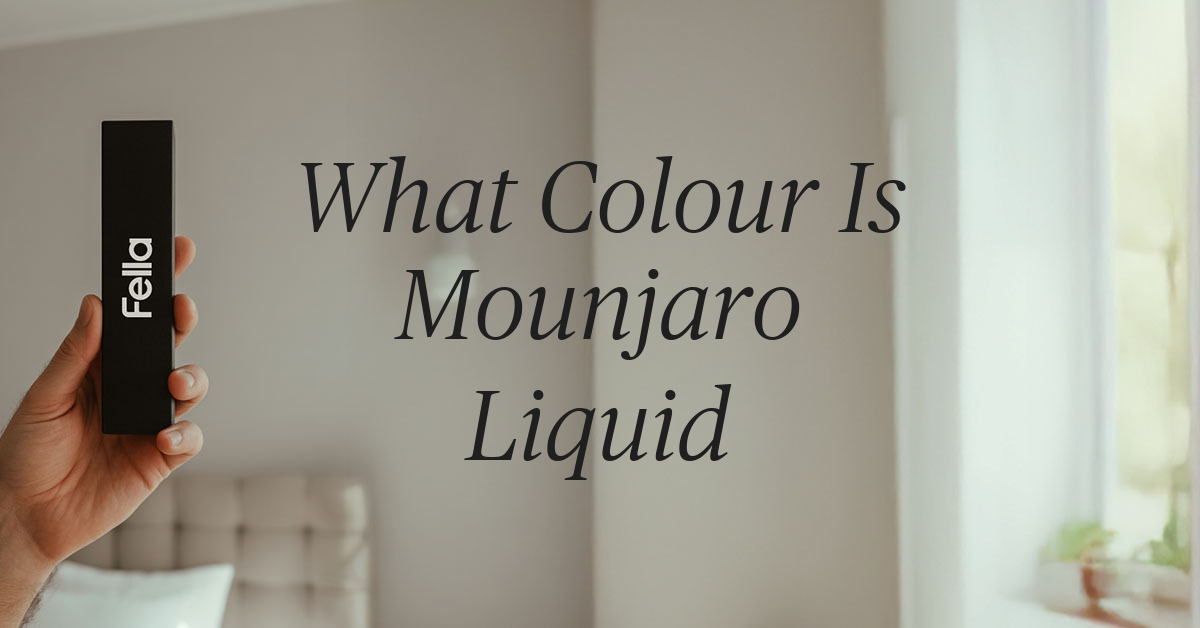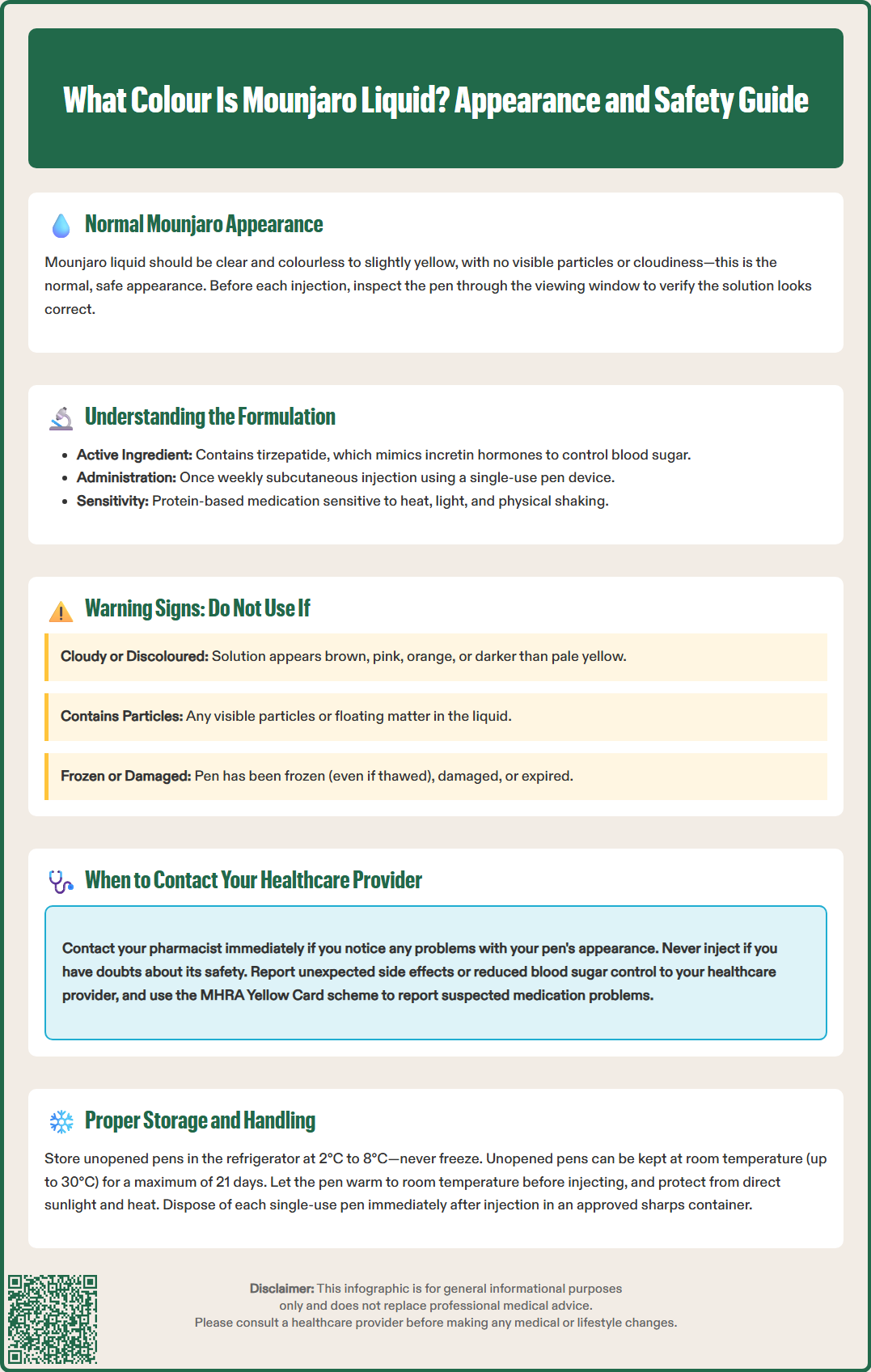LOSE WEIGHT WITH MEDICAL SUPPORT — BUILT FOR MEN
- Your personalised programme is built around medical care, not willpower.
- No generic diets. No guesswork.
- Just science-backed results and expert support.
Find out if you’re eligible

Mounjaro (tirzepatide) is a once-weekly injectable medication prescribed for type 2 diabetes mellitus and weight management in adults with obesity or overweight with weight-related comorbidities. Understanding what your Mounjaro liquid should look like is essential for safe medication use. The solution inside a Mounjaro pen should be clear and colourless to slightly yellow, free from particles or cloudiness. Inspecting your pen before each injection helps ensure the medication has not degraded and remains safe and effective. This article explains the normal appearance of Mounjaro, when to be concerned, and how proper storage maintains medication integrity.
Quick Answer: Mounjaro liquid should be clear and colourless to slightly yellow, free from particles or cloudiness.
The liquid inside a Mounjaro pen should be clear and colourless to slightly yellow. This is the normal appearance of the solution as described in the Mounjaro Patient Information Leaflet (PIL), and slight variations within this range are acceptable. The solution should also be free from visible particles or cloudiness. Before each injection, it is essential to inspect the liquid through the viewing window of the pen to ensure it meets these criteria.
If you notice that your Mounjaro solution appears cloudy, discoloured (particularly if it has turned brown, orange, or any other unusual colour), contains particles, or shows signs of having been frozen, you should not use the pen. These changes may indicate that the medication has degraded or been compromised, which could affect both its safety and efficacy. Using a pen with altered solution characteristics may result in reduced therapeutic benefit or potential adverse reactions.
Patients should familiarise themselves with the normal appearance of their medication when they first receive it. Taking a moment to inspect the pen before each use is a simple but important safety check. If you are ever uncertain about whether your Mounjaro pen looks correct, contact your pharmacist or healthcare provider for guidance before administering the dose. Never use a pen if you have any doubts about its appearance or integrity.

Mounjaro contains tirzepatide, a dual glucose-dependent insulinotropic polypeptide (GIP) and glucagon-like peptide-1 (GLP-1) receptor agonist. This medication works by mimicking the action of incretin hormones, which help regulate blood glucose levels by stimulating insulin secretion when blood sugar is elevated, suppressing glucagon release, and slowing gastric emptying. The formulation is designed to be administered once weekly via subcutaneous injection.
The clear to slightly yellow appearance is characteristic of the Mounjaro solution, as specified in the product's Summary of Product Characteristics (SmPC). The solution is carefully formulated to maintain the stability and bioavailability of tirzepatide. The exact composition, including all excipients, can be found in the SmPC available on the Electronic Medicines Compendium (EMC) website.
The pen device itself is engineered to protect the medication from light and physical damage during storage and handling. Each pen contains a single dose of tirzepatide at one of several available strengths (2.5 mg, 5 mg, 7.5 mg, 10 mg, 12.5 mg, or 15 mg), and the pen is designed for single use only. After administration, the pen should be disposed of safely in a sharps container, even if some solution remains.
Understanding the formulation helps patients appreciate why proper storage and handling are crucial. Protein-based medications like tirzepatide are sensitive to environmental factors such as temperature, light, and physical agitation, all of which can affect the solution's appearance and therapeutic properties. Maintaining the integrity of the formulation ensures optimal clinical outcomes.
Recognising when your Mounjaro pen may be compromised is an important aspect of safe medication use. You should not use your Mounjaro pen if you observe any of the following:
Cloudiness or turbidity – The solution should be clear, not milky or hazy
Unusual discolouration – Colours such as brown, pink, orange, or any shade significantly darker than pale yellow
Visible particles – Any floating matter, sediment, or crystalline material
Signs of freezing – This may indicate the medication has been frozen
Damaged pen – Cracks, leaks, or a pen that has been dropped from a significant height
Expired medication – Always check the expiry date printed on the pen label
If you notice any of these issues, do not attempt to use the pen. Contact your pharmacist immediately for advice. They can assess the situation and advise on next steps, which may involve contacting the manufacturer or your prescriber for a replacement.
It is also important to be aware that freezing damages Mounjaro irreversibly. If your pen has been accidentally frozen (even if subsequently thawed), the solution may appear normal but the medication's efficacy will be compromised. If you suspect your pen has been exposed to freezing temperatures, discard it and seek advice about obtaining a new one.
Patients should report any concerns about medication appearance to their healthcare provider, especially if they experience unexpected side effects or reduced glycaemic control. The Medicines and Healthcare products Regulatory Agency (MHRA) operates a Yellow Card scheme for reporting suspected side effects (adverse drug reactions) and problems with medicines or medical devices. Both patients and healthcare professionals can submit reports via yellowcard.mhra.gov.uk or the Yellow Card app.
Correct storage of Mounjaro is essential to maintain the medication's stability, efficacy, and safety. Following the manufacturer's storage guidelines will help ensure your medication remains in optimal condition throughout its shelf life.
Storage of unopened pens:
Store in a refrigerator at 2°C to 8°C
Keep the pen in its original carton to protect from light
Do not freeze – if frozen, discard the pen
Do not store in the freezer compartment or touching the freezer element
If needed, unopened pens may be kept at room temperature (up to 30°C) for up to the maximum period stated in the UK PIL/SmPC (commonly up to 21 days)
Important handling advice:
Allow the pen to reach room temperature before injecting to improve comfort
Do not shake the pen
Never leave Mounjaro in direct sunlight or in hot environments such as cars
Protect from excessive heat and light
Keep out of sight and reach of children
Transport carefully when travelling – consider using an insulated medication travel case
After injection:
Mounjaro pens are for single use only
Dispose of the used pen immediately in an approved sharps container, even if some solution remains
Follow local NHS arrangements for the disposal of sharps containers
If you are travelling, particularly abroad, plan ahead to ensure you can maintain appropriate storage conditions. Many patients find insulated medication pouches with ice packs helpful for short journeys, though care must be taken to prevent the pen from coming into direct contact with ice or frozen gel packs.
When to seek advice: If your medication has been stored incorrectly (for example, left out of the refrigerator for an extended period, or exposed to high temperatures), contact your pharmacist for guidance. They can advise whether the pen is still safe to use or whether you need a replacement. Your GP or diabetes specialist nurse can also provide advice on proper storage and handling techniques, and many diabetes centres offer practical training sessions for patients starting new injectable medications.
Do not use the pen if the solution appears cloudy, discoloured, or contains particles. Contact your pharmacist immediately for advice, as these changes may indicate the medication has degraded and could affect safety and efficacy.
No, freezing irreversibly damages Mounjaro even if the solution appears normal after thawing. Discard any pen that has been frozen and contact your pharmacist for a replacement.
Store unopened Mounjaro pens in a refrigerator at 2°C to 8°C in the original carton to protect from light. Never freeze the pens, and avoid exposure to direct sunlight or excessive heat.
All medical content on this blog is created based on reputable, evidence-based sources and reviewed regularly for accuracy and relevance. While we strive to keep content up to date with the latest research and clinical guidelines, it is intended for general informational purposes only.
DisclaimerThis content is not a substitute for professional medical advice, diagnosis, or treatment. Always consult a qualified healthcare professional with any medical questions or concerns. Use of the information is at your own risk, and we are not responsible for any consequences resulting from its use.